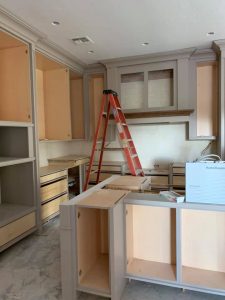How To Plan A Renovation (Without Going Crazy)
Back on the subject of renovations!
After we revealed our new renovation project a little while ago, quite a few of you wrote and asked that we share our planning process for the renovation… That totally surprised me because let’s be honest, the planning stage isn’t the sexiest stage, and I had wondered whether you guys would want me to HURRY UP and share the house all made over. If you’re one of those people, you’ll be happy to know that it’s all coming together fairly quickly, with Ben and the team ploughing on to create something really cool. I’ll be sharing the plans and progress with you shortly, but in the meantime, for those of you who asked I present you… the ins and outs of planning a renovation! Let me first start by saying that obviously, every renovation is different, which is what makes it so fun (and challenging!). So what I’m sharing here is the process we used to plan our renovation, and I think they apply to most renovations!
WORK OUT A BUDGET
The first place to start when planning your renovation is… BUDGET! How much money you want to spend will determine what you are able to do – are you simply doing a general pretty up with a new coat of paint, or are you doing a full-blown remodel? When we started, the first thing we did was work out how much money we could afford to spend, factoring the cost of the property and how much we had/wanted to borrow. Because we are doing a full remodel, with a new level and a complete overhaul, straight away we knew that the budget would be tight, and we would be doing everything we could to create bespoke-inspired style on a budget. That’s the bit I’m most inspired to share with you!
GATHER INSPIRATION
Now, the fun part! Time to put together some ideas for how you want your space to look and feel once it’s done. To do this, we spent time putting together ideas and pulling imagery that reflected both the structural elements we wanted to see as well as the decor. My main focus at first was the decor but it was really great to be guided by Ben through the structural things like space and orientation. I created some mood boards and have added to them throughout the process, adding DIYs, landscaping ideas and pretty much everything that inspires me.
CREATE & REFINE YOUR SCOPE
The next thing we did was to refine the ideas into actual elements that we wanted to see, designing the space and the elements that would be in it. This became a bit of a wish list for the house, which is essentially a scope of works. At this point, it’s a good idea to get an idea of the broad costs associated with your plans, and one way to do that is to get in touch with a builder or consult an online guide. For us, the original scope came in over budget (hello renovating!) so we tweaked some of the things we wanted and focused on our key priorities like light, space and yield. This stage will often be a process of going back and forth but it’s worth it to get it right
DESIGN THE SPACE
Once you’ve finalised your scope, it’s time for design! Depending on the project, you might need detailed drawings like layouts and cross-sections. You can develop drawings for using an architect, but that said, depending on the scale of your renovation you don’t always need drawings. The bigger and more complex the project the more you should consider drawings. A builder can often do a renovation for you without them just going by eye and communication – although in this case you often won’t get the perfect finish (but it might be worth it if your money is tight). Luckily for us, Ben and his team created drawings for the new design in literally no time, admittedly taking the headache/cost out of the process and meaning we could condense this stage into just a few days. They created plans (flat layouts) and elevations of the whole house and even sketch up (real life) models of the outside, bathrooms and kitchen/living/dining space in a very short amount of time. *You may have to submit your drawings to the council/authorities at this stage, something we didn’t have to do because the house had an existing approval on it – something that was both a blessing and a curse

How To Start Your House Renovation
Are you thinking of renovating or extending your home but don’t know where to start? Or perhaps you are looking at purchasing a new property and you’re not sure whether you will be able to turn it into your dream home? Envisaging the fantastic possibilities is exciting. But, even if you have built before, working out where to start with a house renovation can be daunting.
Check whether there are any restrictions on development
This is a very important threshold question. A regulatory restriction on changing the look of, or extending, the property can turn house renovation plans on their head. It is better to know whether there are any regulatory restrictions from the outset, so you don’t end up wasting time and money on a project that will not be permitted.
Visit your local Council offices and talk to one of the Council planners about what you can and can’t do under the relevant planning scheme. We also recommend that you talk to an officer from the Council’s building department, as in some cases there are building restrictions that you need to be aware of. For example, we recently completed a renovation where the owner was not aware that there was a set back restriction under the building regulations – which the Council’s planning department had (unhelpfully) failed to mention because it was dealt with by the building department.
Are there any restrictions on the property’s title?
Check the property’s title to check whether any restrictions on development have been registered on it. For example, a restrictive covenant that places restrictions on building material or on the size of the floor plan. Also, check for easements that might affect the size and layout of an extension.
If you are planning a ground floor extension, are any relevant reports available?
Check whether any preliminary reports, such as soil tests and contour surveys, have already been prepared. The results from these reports can have a significant effect on the design and cost of a ground floor extension. For example, if the property is on poor quality soil, the foundations may need to go deeper than normal.

Preparing Your Home and Yourself for Major Renovations
You’re smart to have decided to contract out your major home project. Remodeling a kitchen or bathroom, building an addition, or totally remodeling your home are all jobs that extend far beyond the skill level of most homeowners
If you have ever survived an arduous do-it-yourself project, finding a contractor may give you a sense of relief, as you envision yourself telling the contractor what to do and then having it magically done for you.
But while your physical labor will be minimal, a different kind of work is involved: preparing yourself, preparing your home, and dealing with your contractor. Let this guide ease your home’s transition into a gorgeous sanctuary that you will love for many years to come.
There is a season for everything, and some seasons are better than others for major remodeling projects. For most exterior house projects, such as painting or deck-building, temperate seasons such as late spring, summer, and early fall are best. For roofing projects, the middle of the summer provides the longest stretch of dry weather. Interior projects can be done at any time of year, as they are independent of the weather.
Should You Stay or Should You Go?
The timeline for building that addition is eight weeks. The timeline for your once-in-a-lifetime trip to Europe: eight weeks. Like peanut butter and chocolate, they just go together, right?

Things to Know Before Starting a Home Renovation
You might be thinking of renovating your home by doing it yourself or hiring an interior design firm like Interiors Remembered, Inc. to tackle the project for you. Either way, there are some things you should consider and be prepared for before starting your renovation.
What Exactly are You Renovating?
The first thing to think about before you start your home renovation is what exactly you want to upgrade. It could be a few different things such as making the rooms more functional, knocking down walls for a bigger area, or just need an updated look.
Freely Express Your Ideas
This is YOUR renovation. Always clarify exactly what you want and ask as many questions as you need to feel comfortable moving forward. Start by setting goals and making a list of things you want to achieve, any questions you have, and how to properly move forward.
Know What to Expect Next
Another benefit of working with a firm on your home’s renovation is that they are pros, they have done this before and know what to expect next in the plan.
Don’t Be Scared!
We understand that you might be afraid to jump into such a big project like renovating your home. But now is the time to plan what you want and tackle it, without fear! If you are working with our interior design firm, you are in good hands! We will help you navigate through the entire process, from talking to you about what you want, planning on how to turn your vision into reality, and all of the steps it will take, especially your timeline and budget.

Things to Consider Before Borrowing For Your Home Renovation Project
Home renovation projects can easily snowball, and there are multiple ways out there to finance the undertaking. To help you assess the financial viability of your remodelling project, below we discuss why you might find borrowing for a renovation project helpful, as well as some precautions before you knock on the bank’s door.
Renovation loans can boost your returns
Aside from enabling people to get one step closer to their dream homes, renovation loans can also help investor-minded homeowners to boost the returns on their home remodeling projects. This is especially true if the property was bought at a depressed value for some reason (old, flooded, burnt, etc.), and needs a face-lift to prepare for a fix-and-flip.
you will probably run out of money even before you notice any difference. Effectively, you are unlikely to recoup any meaningful returns because your property probably looks the same, and it can only sell for about the same price that you purchased it for. Considering the time and effort you put towards the renovation and the transaction costs, this sounds like a bad deal.
Watch out for interest costs that eat out your returns
However, borrowing to do a larger-scale project isn’t always the best idea, especially if your property is already functional and the nature of the renovation is for luxury. This is because renovation tends to have a diminishing marginal return as the project gets more expensive. For example, let’s say you can do either a S$30,000 or a S$50,000 kitchen renovation project. If you are financing the project with 100% loan, then the total interest costs you will incur are S$2,269 and S$3,782, respectively, with a difference of S$1,513 in incremental interest cost
However, you should carefully investigate whether a S$50,000 kitchen can recoup more profit than a S$30,000 one to justify the S$1,500 cost. This is because high-end features and functionalities become more personalised, and a potential buyer may not value certain things like expensive materials and built-in dishwashers in the first place. Your buyer will pay you more than your cost if and only if the renovation work is at least as good as (if not better than) what they would’ve done on their own anyway.